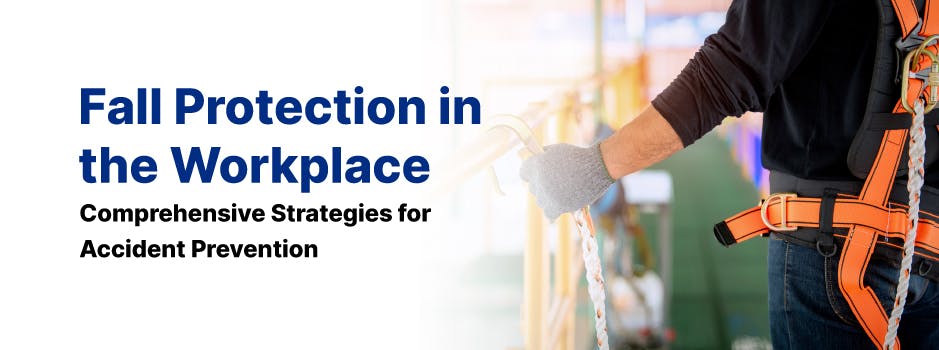Falls are a leading cause of workplace injuries and fatalities, making fall protection a critical component of any safety program. Implementing effective fall protection measures can help prevent accidents, protect workers, and ensure compliance with regulatory requirements. This guide will provide an overview of fall protection strategies, discuss the importance of hazard assessment and training, and offer practical tips for implementing a comprehensive fall protection program in your workplace.
Understanding Fall Hazards
Types of Fall Hazards
Fall hazards in the workplace can be categorized into two main types:
- Falls from heights: These occur when workers fall from an elevated surface, such as a roof, scaffold, or ladder. Falls from heights can result in severe injuries or fatalities, especially when fall protection measures are not in place.
- Falls on the same level: Also known as slips, trips, and falls, these incidents occur when workers lose their balance or footing on a walking or working surface. While falls on the same level may be less severe than falls from heights, they can still cause significant injuries and lost productivity.
Identifying Fall Hazards in the Workplace
To implement an effective fall protection program, it is essential to identify and assess all potential fall hazards in your workplace. This process should involve:
- Conducting a thorough inspection of the work environment, including elevated work surfaces, walkways, and stairways
- Identifying hazards such as slippery surfaces, uneven floors, or obstructions that could cause falls on the same level
- Evaluating the risk of falls from heights by considering factors like the height of work surfaces, the presence of guardrails or fall arrest systems, and the tasks being performed
Fall Protection Strategies
Preventing Falls from Heights
Implementing measures to prevent falls from heights is crucial for protecting workers and ensuring compliance with regulatory requirements. Some effective strategies include:
- Guardrails: Install guardrails around elevated work surfaces to provide a physical barrier that prevents workers from falling.
- Safety nets: Use safety nets below elevated work areas to catch workers in the event of a fall.
- Fall arrest systems: Equip workers with personal fall arrest systems, such as harnesses, lanyards, and anchor points, to stop a fall in progress and minimize the risk of injury.
- Fall restraint systems: Use fall restraint systems, like body belts and short lanyards, to prevent workers from reaching an unprotected edge and falling.
Preventing Falls on the Same Level
Reducing the risk of falls on the same level involves addressing hazards related to walking and working surfaces. Strategies for preventing slips, trips, and falls include:
- Housekeeping: Maintain clean and organized work areas, ensuring that walkways are free of debris, liquids, or other obstructions.
- Surface maintenance: Repair or replace damaged flooring, and use slip-resistant materials or coatings where appropriate.
- Lighting: Ensure adequate lighting in all work areas and walkways to help workers see potential hazards and maintain their balance.
- Signage: Use signs and markings to warn workers of potential hazards, such as wet floors, uneven surfaces, or changes in elevation.
Implementing a Comprehensive Fall Protection Program
Hazard Assessment and Control
Conduct regular hazard assessments to identify, evaluate, and control fall hazards in your workplace. This process should involve:
- Inspecting the work environment for potential fall hazards and documenting your findings
- Prioritizing hazards based on their severity and likelihood of causing injury or accidents
- Implementing appropriate control measures, such as those mentioned in sections 2.1 and 2.2, to prevent falls and minimize risks
- Monitoring and evaluating the effectiveness of implemented controls, and adjusting your strategies as needed to maintain a safe work environment
Training and Education
Provide comprehensive training and education for all workers who may be exposed to fall hazards, ensuring they understand the risks associated with their tasks and are competent in the required safety procedures. This includes:
- Educating workers on the types of fall hazards present in the workplace and the importance of following fall protection measures
- Providing hands-on training in the proper use, inspection, and maintenance of fall protection equipment, such as personal fall arrest systems and fall restraint devices
- Offering refresher training to reinforce key concepts and ensure workers remain knowledgeable about fall protection best practices
Equipment Selection and Maintenance
Selecting appropriate fall protection equipment and maintaining it in good working condition is crucial for ensuring worker safety. Consider the following when selecting and maintaining fall protection equipment:
- Choose equipment that is suitable for the specific tasks and hazards present in your workplace, and ensure it meets applicable regulatory standards
- Inspect fall protection equipment before each use, checking for signs of wear, damage, or defects
- Remove damaged or defective equipment from service and replace it with properly functioning gear
- Train workers on the proper care, storage, and inspection of fall protection equipment to prolong its lifespan and ensure its effectiveness
Continuous Improvement
Regularly review and update your fall protection program to ensure it remains effective and reflects any changes in your workplace, industry standards, or regulatory requirements. This includes:
- Analyzing incident reports, inspection findings, and feedback from workers to identify areas for improvement in your fall protection measures
- Incorporating lessons learned from actual incidents or near misses to enhance the effectiveness of your fall prevention strategies
- Staying informed about industry best practices and regulatory updates related to fall protection, and updating your policies and procedures accordingly
Conclusion
Fall protection is an essential aspect of workplace safety, helping to prevent injuries and fatalities related to falls from heights and falls on the same level. By conducting thorough hazard assessments, implementing effective fall prevention strategies, and providing comprehensive training and education, organizations can create a safer work environment and reduce the risk of accidents. Regularly reviewing and updating your fall protection program will ensure it remains effective and compliant with industry standards and regulatory requirements.

